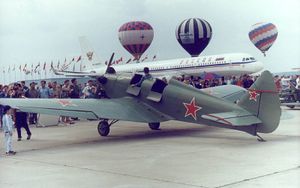Yakovlev UT-2
| UT-2 | |
|---|---|
 |
|
| Role | Trainer/Fighter-trainer |
| National origin | USSR |
| Manufacturer | Yakovlev |
| Designer | Aleksandr Sergeyevich Yakovlev |
| First flight | 11 July 1937 - Ya-20 |
| Number built | 7,243 |
| Developed from | AIR-10, Ya-20 |
The Yakovlev UT-2 (Russian: УТ-2, NATO reporting name "Mink") is a trainer aircraft used by the Soviet Air Force from 1937 until the 1950s. It was the standard Soviet trainer during World War II.
Contents
Development
The UT-2 was designed as a trainer, more suitable for training pilots of modern and fast aircraft than the older U-2 (Po-2) biplane. The new plane was designed by Yakovlev's team at OKB-115. The next design, AIR-10, was based upon the AIR-9, but it was simpler, with two separate open cockpits, and lacking slats and flaps. It was flown on 11 July 1935. The AIR-10 won the competition with other trainer designs in 1935 and, after changes, was accepted as the standard Soviet Air Force trainer. A temporary designation for this plane became Ya-20 (Я-20). This is just because of the original AIR was the abbreviated name of Alexey Ivanovich Rykov, a communist leader executed in 1938; Yakovlev changed names of his aircraft to the politically safe Ya. The mixed construction (wood and metal) of the AIR-10 was changed to wooden only, to simplify production. A prototype used the 112 kW (150 hp) Shvetsov M-11E radial, but production aircraft used 82 kW (110 hp) M-11Gs. Serial production started in September 1937. The plane was given the designation UT-2 (uchebno-trenirovochnyi {учебно-тренировочный}, primary/advanced trainer).
The UT-2 was used also by civilian aviation. However, it soon demonstrated it was not easy to fly, with a tendency to spin. After some changes to its construction, the plane became safer and was fitted with a 93 kW (125 hp) M-11D, as the UT-2 model 1940.
To improve handling and stability, a new UT-2M (modernized) variant was developed in 1941 and put into production. The shape of wings was totally new, with a swept leading edge instead of a straight one (the wing's trailing edge was now straight), and the tailfin was larger.
In total, 7,243 UT-2 and -2Ms were produced in five factories between 1937 and 1946. Despite all improvements, the handling and flight characteristics of the UT-2 were never excellent. In the 1950s they were replaced with the Yak-18 as a primary trainer and the Yak-11 as an advanced trainer. After the war, the UT-2 and -2M were also used by countries like Poland and Hungary.
Variants
- AIR-10 UT-2 precursor.
- AIR-11 - Three-seat prototype.
- Ya-20 UT-2 prototype.
- UT-2 (initial production)- too prone to spin.
- UT-2 (1940 standard) - modified to improve spin characteristics.
- SEN (UT-2N) - Air cushion landing gear tests.[1]
- UT-2M - Production from 1941, re-designed wings.
- UT-2MV - Light Bomber
- UT-2V - Bombing Trainer
- Yak-5 - Single-seat fighter trainer development of UT-2
Operators
- Normandie-Niemen unit
- SFR Yugoslav Air Force
- 1st Training Aviation Regiment (1945-1948)
- 104th Training Aviation Regiment (1948-1956)
- Liaison Squadron of 5th Military district (1952-1956)
- Liaison Squadron of 3rd Aviation Corps (1950-1956)
Specifications (UT-2, 1940 standard)
Data from Gordon 2005, and Gunston 1995
General characteristics
- Crew: 2
- Length: 7.15 m (23 ft 5-1/2 in)
- Wingspan: 10.2 m (33 ft 5-1/2 in)
- Height: 2.99 m (9 ft 10 (tail up) in)
- Wing area: 17.12 m2 (184.3 ft2)
- Empty weight: 628 kg (1,385 lb)
- Gross weight: 940 kg (2,073 lb)
- Powerplant: 1 × Shvetsov M-11D, 93.2 kW (125 hp)
Performance
- Maximum speed: 210 km/h (131 mph)
- Cruising speed: 99 km/h (60 mph)
- Range: 1,130 km (702 miles)
- Service ceiling: 5,000 m (16,400 ft)
- Rate of climb: 3.3 m/s (649 ft/min)
Armament
- 2 or 4 x 50 kg (110 lb) bombs (UT-2MV Light Bomber).
- 2 x 50 kg (110 lb) bombs + 8 x RS-82 rockets (UT-2MV Light Bomber).
See also
- Aircraft of comparable role, configuration and era
- Related lists
Notes
References
| Wikimedia Commons has media related to Yakovlev UT-2. |
- Lua error in package.lua at line 80: module 'strict' not found.
- Lua error in package.lua at line 80: module 'strict' not found.
